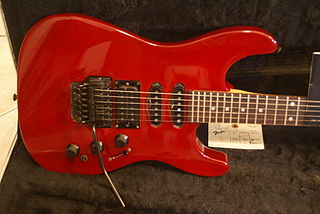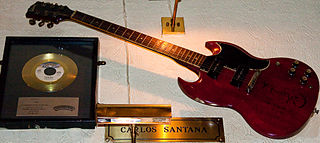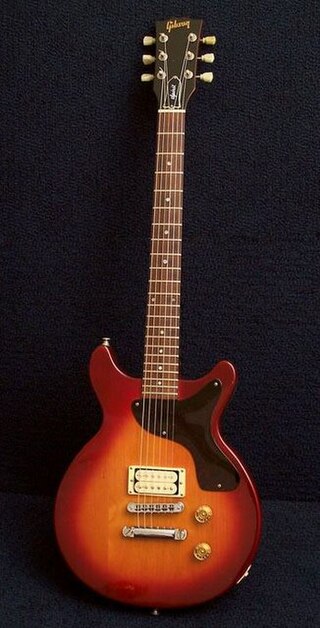
renamed from "Les Paul Special Doublecut" in the late 1959, due to the discontinuation of Les Paul affiliation.
The Gibson Les Paul Doublecut is a double-cutaway version of the Gibson Les Paul electric guitar.

The Gibson Les Paul Doublecut is a double-cutaway version of the Gibson Les Paul electric guitar.
Except for Gibson Custom Shop/Historic models, there are currently four types of the Les Paul double cut model.
Standard & Pro Doublecut|Les Paul Doublecut 'Pro

One of the first Les Paul Doublecut is the Les Paul Junior Doublecut released in 1958. Like the singlecut version of the LP Junior, it has a single "dog-eared" P-90 single coil pickup. This Les Paul doublecut is currently only available as a Gibson Custom Shop/Historic Reissue model, called the "1958 Junior Doublecut." The Junior, in both its singlecut and doublecut forms, was originally Gibson's "student" model. The initial price of the Les Paul Junior was originally $49.50.
It is also one of the least expensive Les Paul guitars available. It appears that Gibson has since decided to discontinue much of the faded lines, including the Les Paul Special Double cut for its 2009 lineup.
A much more expensive and historically accurate version of this guitar, the 1960 Les Paul Special, is available as a Custom Shop/Historic Reissue model.
For many years after 1960 no Les Paul Doublecut guitars were produced by Gibson, and when Gibson did start making doublecut Les Pauls again, they were re-issues closely following the original Les Paul Special flat-top (no carved maple cap) design, with P-90 pickups rather than humbucker pickups. In the interim, during the 1970s, a small boutique USA guitar producer, Hamer, began making both flat-top and carved-top doublecutaway guitars very similar to the then-dormant Gibson designs. These Hamer versions of doublecutaway Les Pauls got widespread publicity for their use by the members of the rock band Cheap Trick and others.
The Faded Doublecut has its origin in the Les Paul Special Doublecut, which is an all-mahogany flat-top guitar with P-90 pickups first produced from 1958–1960. The "Faded" model is called such because the nitrocellulose finish is not thick and glossy like the original vintage examples or Custom Shop double cut Les Pauls. This finish style is easily susceptible to play wear, thus many examples appear to have been "relic'ed" in the factory, but the wear is real. The body is composed of multiple mahogany (usually four) pieces and is sold with a gig-bag (as opposed to a hard-case).
The Doublecut had one major design change: the original models had the neck pickup mounted closer to the neck/body join which resulted in a weak neck join. This was changed by moving the neck pick up further into the body.
The "Faded Doublecut" is one of a series (at least as of 2007) "faded" models being the SG, Les Paul (single cut with humbuckers) and Flying V. All of these models are made in the USA.

The Les Paul Standard and Pro models of the doublecut LP are a newer concept, based on an arched-top Les Paul with humbucker pickups, similar to the Hamer design. The Pro has 22 frets; the Standard has 24 frets. The Standard "Plus" has gold hardware. Unlike other 2-pickup single cutaway Les Pauls, these Gibson doublecutaway versions have one master volume and one master tone control (singlecut Les Pauls with two pickups have two sets of tone and volume controls, one for each pickup). Many believe these newer archtop doublecut Les Pauls were developed in response to the high-end guitars of Gibson competitor Paul Reed Smith (PRS), whose PRS guitars most typically have a doublecut design and master tone and volume controls, and whose production eventually went from a small shop (as Hamer's has stayed) to an assembly-line production rivaling Gibson's. This opinion is further supported by the fact that the first of Gibson's archtop doublecut Les Pauls, the now-discontinued Les Paul Studio doublecut (produced in the late 1990s), had 24 frets, as opposed to Gibson's more standard 22 frets. 24-fret necks are featured on some PRS guitars, and are more popular with heavy metal players who often solo at the high end of the neck.

The Gibson SG is a solid-body electric guitar model introduced by Gibson in 1961, following on from the 1952 Gibson Les Paul. It remains in production today in many variations of the initial design. SG stands for "solid guitar".

The Gibson Les Paul is a solid body electric guitar that was first sold by the Gibson Guitar Corporation in 1952. The guitar was designed by factory manager John Huis and his team with input from and endorsement by guitarist Les Paul. Its typical design features a solid mahogany body with a carved maple top and a single cutaway, a mahogany set-in neck with a rosewood fretboard, two pickups with independent volume and tone controls, and a stoptail bridge, although variants exist.

Paul Reed Smith Guitars, also known as PRS Guitars or simply PRS, is an American guitar and amplifier manufacturer located in Stevensville, Maryland. The company was founded in 1985 in Annapolis, Maryland by Paul Reed Smith. Products manufactured by PRS include electric and acoustic guitars, basses, and amplifiers.

Superstrat is a name for an electric guitar design that resembles a Fender Stratocaster but with differences that clearly distinguish it from a standard Stratocaster, usually to cater to a different playing style. Differences typically include more pointed, aggressive-looking body and neck shapes with increased cutaways to facilitate access to the higher frets, an increased number of frets on the fingerboard, a contoured heel at the neck joint facilitating easier higher fret access, the usage of humbucking pickups, and locking vibrato systems, most commonly the Floyd Rose.

The G-400 is an Epiphone solid body electric guitar model produced as a more modestly priced version of the famous Gibson SG. Currently, Epiphone is a subsidiary of Gibson and manufactures the G-400 and other budget models at a lower cost in Asia. Visually and ergonomically, it is almost identical to a 1962 SG.

The P-90 is a single coil electric guitar pickup produced by Gibson Guitar Corporation since 1946, as well as other vendors. Compared to other single coil designs, such as the Fender single coil, the bobbin for a P-90 is wider but shorter. The Fender style single coil is wound in a taller bobbin, but the wires are closer to the individual poles. This makes the P-90 produce a somewhat warmer tone with less edge and brightness, As with other single-coil pickups, the P-90 is subject to AC hum unless some form of cancellation is used.

Fender Telecaster Custom is a model of electric guitar made by Fender.
The Gibson Les Paul Junior is a solid-body electric guitar introduced in 1954 as an affordable, entry-level Les Paul. It was first released with a single-cutaway body style; models with a double-cutaway body style were introduced in 1958. The Junior continued through the first three years of the Les Paul/SG body redesign. The initial run was discontinued in 1963.
The Gibson Melody Maker is an electric guitar made by Gibson Guitar Corporation. It has had many body shape variations since its conception in 1959.
The Gibson Les Paul bass is a bass guitar first manufactured by Gibson in 1969, just after the relaunch of the Les Paul guitar in 1968.
The Gibson Les Paul Custom is a higher-end variation of the Gibson Les Paul guitar. It was developed in 1953 after Gibson had introduced the Les Paul model in 1952.

The Gibson SG Special is an electric guitar made by Gibson that has been manufactured since 1961.
The Gibson ES series of semi-acoustic guitars are manufactured by the Gibson Guitar Corporation.

A cutaway on the guitar construction is an indentation in the upper bout of the guitar body adjacent to the guitar neck, designed to allow easier access to the upper frets.

Michael Zachary Myers is an American musician, singer, and songwriter who founded and is currently the lead singer and guitarist for the rock band The Fairwell. He is also the former bassist and current guitarist for the hard rock band Shinedown, as well as member of Allen, Mack, Myers, & Moore. He also embarked on a comedy career as part of the duo Campfire Astronauts with comedian Chris Porter.

The Gibson Spirit was a guitar model sold under Gibson and Epiphone USA nameplates in the 1980s. This article does not refer to the made-in-China Spirit guitar sold under the Gibson Baldwin Music Education nameplate.

The Gibson Les Paul Special is a variation of the Gibson Les Paul guitar. It was introduced in 1955. It is designed to be an intermediate level instrument, at a price point and trim level between the low-cost Les Paul Junior and the standard Les Paul.
The Fender Telecaster, colloquially known as the tele, is an electric guitar produced by Fender. Together with its sister model the Esquire, it was the world's first mass-produced, commercially successful solid-body electric guitar. Its simple yet effective design and revolutionary sound broke ground and set trends in electric guitar manufacturing and popular music. Many prominent rock musicians have been associated with the Telecaster for use in studio recording and live performances, most notably Bruce Springsteen, Prince, Luis Alberto Spinetta and Keith Richards.

The Gibson ES-350T is an electric guitar model from Gibson Guitar Corporation, released in 1955. The ES-350T is a further development of the Gibson ES-350 model from 1947 and as such has a completely hollow body. The unique feature of the Gibson ES-350T at the time of its market introduction was the reduced width of the rims. As a result, the guitar has a thinner body compared to instruments with a resonance body that is of full thickness. The ES-350T, together with its sister models Gibson ES-225 TDN and Gibson Byrdland, was one of the first models of the thinline guitar type.